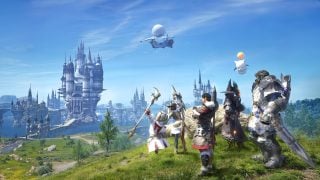I was very, very young when I first laid eyes upon The Legend of Zelda: Ocarina of Time. I had gone over to my neighbor’s house for reasons I can’t remember, and watched as he pulled out a N64 with the cartridge already inside. He casually tossed me the strategy guide to distract me as he played, and I poured through the pages while glancing at his dungeon escapades.
I was enraptured.
Most of my experiences with the game would come years later, when my family acquired the GameCube “Master Quest” edition by pre-ordering Wind Waker. But I’ll never forget that memory – one that resonates all these years later as the first time I witnessed one of the greatest video games of all time, and one of the most important ones I’ve ever played.
Bold new world
Previous Zelda entries had offered expansive worlds, but Ocarina not only propelled the visuals to 3D – it offered a grand new place to explore the likes of which were unseen in video games of the time. Who forgets their first time viewing the vast expanse of Hyrule field, the airy greenery of Kokiri Forest, or the the treacherous paths of Death Mountain? It may seem paltry today, but at the time Ocarina offered a truly massive, versatile world for the player to explore, full of secrets to discover.

And what helped this feeling was the various NPCs scattered across the gamescape, who all injected a sense of life and quirkiness into Hyrule. From the mustachioed owners of Lon Lon Ranch to the burly Gorons to many, many more besides; Ocarina of Time set the standard for denizens of Hyrule going forward, giving many of them distinct personalities and needs for Link to assist with. This was one of the first Zelda titles to truly feel like a world to explore, rather than a dangerous playground to trapeze around in.
One aspect of Ocarina I feel is often neglected is its atmosphere. Often overshadowed by the dreary mood of its successor, Majora’s Mask, Ocarina was – and still is, in my estimation – a very atmospheric title, able to provide whimsical adventure and lurking dread in equal amounts. The overworld music was bright and motivational, while dungeon tunes were low and ominous. The Temple of Time in particular stood out with its hollow, monochromatic sense of foreboding. Even graphical effects, like the strange green mist that constantly pervaded the forest region, added to the sense of mystique the game was so ample in providing.
A grand tale
The word “epic” has been bludgeoned to death via over-usage by this point, but I believe that few words describe the feeling of Ocarina’s narrative so well. Much like its console predecessor, A Link to the Past, the title appears to be a more innocuous tale of saving the world via collecting three items, only for things to spiral out of control. In the process of obtaining the Master Sword, Link accidentally lets Ganondorf access the Sacred Realm, plunging the land into darkness and chaos.
While it’s fairly uncomplicated in retrospect, the story of Ocarina had several intriguing factors to it. The fact that you had unwittingly allowed the villain to accomplish his objective was a stunning blow. Realizing that the Sages you needed to find were friends you had made as a child was not only a clever bit of writing, but added a strong emotional connection to your escapades as an adult. And hey, everybody loves a good time travel plot – witnessing the changes in Hyrule that had occurred over seven years was downright gut-wrenching at times, as the game drove home the point that only you, as Link, had the power to save the kingdom.

While not the most innovative story in the Zelda series (both its immediate predecessor, Link’s Awakening, and successor, Majora’s Mask, were likely better overall) Ocarina offered more than enough emotional connection and twists to provide an engrossing experience. Plot details like Sheik actually being Zelda may be well known now, but that’s only because they left such a strong impression upon the gaming community in the first place.
Delightful dungeon-crawling
The jump from 2D to 3D killed many a game franchise. Even titans like Sonic didn’t seem to fully grasp the intricate differences between the styles, and break-out hits like Mario 64 were the exception rather than the standard. Ocarina of Time not only maintained traditional Zelda gameplay in a new dimension – it improved on it.
First off, the innovation of Z-targeting cannot be understated. By allowing the player to lock onto enemies and execute various sword slashes, Ocarina not only expanded Link’s repertoire from two attacks (slice and spin attack) to a much larger variety (horizontal slash, vertical slash, stab, spin attack, jump attack) but single-handedly changed the 3D third-person action game forever. Fighting enemies was fluid and fun, and certain ones – such as the wailing Lizalfos or the brutal mini-boss Dark Link – really tested the limits of your abilities.

Link’s periphery items also benefited greatly from the jump. 1st person aiming with the bow, boomerang and more added another element to both fights and puzzle-solving, opening up a host of new experiences. Items like the hookshot were made more versatile by being in a 3D space rather than a 2D one, and even more simple tools like the Megaton Hammer were a ton (heh) of fun. There was the occasional odd design choice – such as constantly having to pause to equip/unequip the iron boots – but several of these issues were solved in the 3DS remake.
I’d be remiss if I didn’t mention the game’s titular musical instrument. Link’s ocarina proved versatile and iconic, able to change the time of day or teleport him with relative ease. That would have been fine on its own, but the fact that the songs played on the ocarina have become legendary is something in and of itself. Who doesn’t know the Song of Time, or Saria’s Song, or Epona’s Song? With the exception of Zelda’s Lullaby (based on an old ALttP tune) the instrument birthed some of the series’s most iconic music by itself.
Not to mention that the dungeons themselves are among the best in the entire series, still after all this time. Full of brooding vibes and varied enemies, the various temples of the landscape offered multitudinous designs without feeling too gimmicky. From the webs of Inside the Deku Tree to the fleshy apparitions of Inside Jabu-Jabu’s Belly to the wanton trickery of the Shadow Temple, Ocarina’s dungeons are never short of inspiration. I never even found the Water Temple that bad, personally. Plus, if you have the GameCube or 3DS version, then the game comes packaged with a whole second Master Quest that will test the limits of your brain and brawn.
And while it’s also true that Ocarina doesn’t have many unique gameplay features that set it apart like its successors (Wind Waker’s sailing, Skyward Sword’s motion controls, Majora’s Masks… masks) that’s because it set a new standard going forward. Once again taking the lessons of A Link to the Past and utilizing them more effectively in a 3D space, birthing a host of brand new ideas and opportunities in the process, and defining the 3D Action-Adventure game going forward.
Everlasting legacy
There was a time in my life when Ocarina of Time was my absolute favorite game, bar none. The story, the world, the gameplay was all so pure and joyous to behold, and I couldn’t find a single flaw in its design at that time. I travelled across Hyrule countless times, giddy to experience the adventure again and again.
Since then the game’s issues have made themselves more apparent to me, and it’s fallen ever so slightly in my eyes. Yet the pure nostalgia the game inspires is unbridled – simply hearing the opening piano notes on the title screen is enough to sweep me away, back to those simpler times. Like many other impressionable youths, I was influenced immensely by the game as a kid, as it shaped my tastes, preferences, and childhood for years to come.

Ocarina of Time, more than any other game in history, often bears the title of “all-time greatest”. It is an high acclaim, one that, when accredited to most games, causes me to turn up an eyebrow and wonder if this particular title can really receive such an honor. But with Ocarina, it’s more than worthy – with its grace, its magnificence and its innovation, it truly is a game that has stood the test of time.
This article is part of our new Zelda look-back series running up to the release of Breath of the Wild.
Leave a Comment

